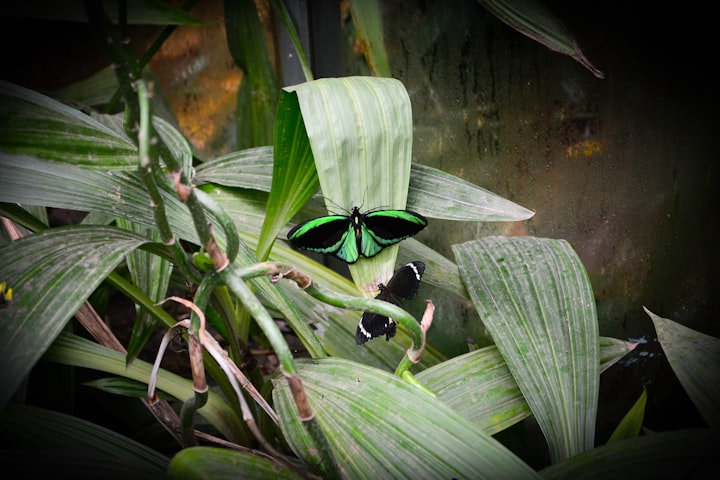How exactly does the parasite burrow into the animal's body?
In the entire biological world, parasitism is a very mainstream way of survival

You may not know that most parasite taxa have been around since before the Mesozoic era, 250 million years ago, which is a bit counter-intuitive, to say the least. Parasites are even older than their current hosts, so how did they survive before their hosts emerged?
Of course, this question is not valid; it is the ancestors of the parasites that have a long history, and each particular parasite today must have gotten their soft food after their hosts emerged.
A tick that parasitizes the body surface of a bat
However, this also raises the ultimate question, how did the first parasites emerge? More bluntly, how did the first parasites burrow into other organisms and then live a life free of food and clothing?
First of all, the parasitic way of life seems so strange to us humans, but throughout the biological world, parasitism is a very mainstream way of survival.
Frogs with deformities due to trematode infection

According to estimates, more than half of the 7.7 million known animal species on earth are parasites (controversial, another 40% are parasites). We, humans, are the best sample, and humans are hosts to more than 100 parasites, a number that doubles if you count viruses, bacteria, and microbes.
The reality is that there is hardly any animal in which parasites cannot be found, and even animals raised strictly in captivity in the laboratory are often infected with parasites.
Some of the parasites that use humans as hosts
Secondly, parasitism does not occur by chance. In previous studies, researchers have estimated that parasites have evolved independently 60 times, while recent studies have found that parasites have evolved independently at least 223 times, which would suggest that many animals coincidentally choose the path of parasitism as a survival strategy with advantages.
So how do we deduce the origin of parasites? The easiest way is to find the old relatives of these parasites who still live a free life. For example, we are most familiar with mosquitoes, they belong to the ectoparasites, but not all mosquitoes suck the blood of animals.
There are about 3,000 species of mosquitoes around the world, of which only about 80 species will bite humans. The ancestors of mosquitoes emerged as early as the Jurassic period, to today's parasitic blood-sucking is just a small episode in their evolutionary history.
In the family of mosquitoes, larvae are living in plant roots and plant food, adults-only mating without feeding the large mosquitoes, there are also larvae feeding on other tsetse, adults sucking the nectar of the giant mosquitoes, and rely on solitary reproduction to enter the fish feed circle of the rocking mosquito.
Often cause fear of the large mosquitoes do not suck blood
Even if the blood-sucking Anopheles, Aedes, and Culex, their male individuals are not blood, but sucking plant sap life, then it is not difficult to speculate that blood-sucking mosquitoes may be in the case of accidental feeding on animal blood, opened up a whole new path of survival, and then further evolved anticoagulant saliva and specialized mouthparts.
The mosquitoes used to extract dinosaur DNA in the movie "Jurassic Park" were nectar suckers or only males
For such in vitro parasites, their evolution must have involved contact with their future hosts in the living space. Another interesting example is the earliest case of parasites found so far.
Zhang Zhifei's team from Northwestern University found a special fossil in Yunnan, 512 million years old, in which the shells of these brachiopods had a variable number of tubular structures attached to them, and the soft tissue inside was not preserved.
Such tubular structures were not owned by the brachiopods but were made by other organisms, but whether their relationship was a common dependent symbiosis or parasitism has caused some controversy.
By measuring the body size of the brachiopods, members of the team found that individuals with more tubular structures were instead smaller in size, and thus presumed that the two were in a parasitic relationship with their hosts. Brachiopods inhale food by opening and closing their shells, and the worms that live in the tubular structures "snatch" food from their mouths, so much so that they cannot survive independently of their hosts.
This is one of the more accepted hypotheses for the origin of ectoparasitism, where two animals live in the same environment, and in long-term contact, the future parasite accidentally finds similar food in the future host, for example, some moths can suck the tears of large mammals, and this model applies to a variety of mosquitoes, fleas, mites.
But there is another category that is the most mysterious and the most interesting to us, which is, of course, the internal parasites, and this is the topic that our title highlights.
Parasitic worms removed from the body of Kobayashi Himeji rat
In the case of internal parasites, how exactly did the first parasite enter the host's stomach? One hypothesis is that the ancestors of these parasites were autotrophic animals, including predators or carrion.
In the case of nematodes, the largest phylum in the animal kingdom, they live all over the earth, and many of them live parasitically and are generally believed to have entered the bodies of certain animals by chance and subsequently developed a parasitic relationship.
A nematode found in a creek in northern Virginia, USA, has its larvae parasitized in insects, but the adults still live autotrophically
If the ancestor of the parasite was saprophytic, then it could be eaten by an animal that is also saprophytic. There are many ways for this kind of accidental entry into a future host, especially in the ocean, where there are always more accidents, such as the following, which sounds a bit heavy-handed.
Motion picture cover
In 2014, a study found that a "cryptic fish" living on the sea floor feeds on sea cucumbers by burrowing into their anuses and eating their guts and gonads. But don't worry, many sea cucumbers would have thrown away their internal organs to save their lives in critical situations, and the parasitic fish will not cause the death of the sea cucumber.
Not only will the crypt fish eat the guts of the sea cucumber, but they will also use the inside of the cucumber as a mating ground, with both male and female crypt fish burrowing into the cucumber together to complete mating. Biologists estimate that the origin of this odd parasitic behavior may be a lack of shelter on the sea floor.
To adapt to this somewhat heavy parasitic life, the crypt fish have to learn special methods. Sea cucumbers breathe through the anus, so the crypt fish must take advantage of the moment when the sea cucumber exhales the water flow and burrow into the anus to bully the old comrade, for which they have evolved a well-developed body lateral line to feel the change of water flow.
The case of the sea cucumber and the hermit fish may be similar to the initial state of the parasite when the hermit fish is still able to move freely and feed on its own. The regeneration of the sea cucumber's internal organs also takes time, and sometimes the hermit fish simply uses it as a shelter.
Motion picture cover
For those parasites that live in the mammalian intestine, the case of the crypt fish is only a Very Easy model. The challenges they face are more complex and extreme, and only one step to burrow into the body is not enough.
The first challenge is the body temperature of the host. The body temperature of a constant-temperature animal is a big challenge for the parasite, and parasites that can live a soft life must adapt to a high-temperature living environment in advance.
The second challenge is the activity of the host's digestive tract. They also need some cuticles and secretions to defend themselves against digestive juices and enzymes, and a constantly peristaltic intestine to expel them from the body, so they also need strong motility or equipment like suckers and small hooks.
The pig tapeworm is attached to the host's intestine by suction cups and small hooks
The third challenge is the low or anaerobic environment in the host, where the oxygen level in the intestine is so low that the parasite needs anaerobic respiration to survive, and here the ancestral saprophytic parasites are at a particular advantage.
The fourth challenge is the hellish host immune system, as a foreign object, long-term stay in the host's body is bound to cause the host's immune response, some parasites can secrete some substances to interfere with the host's immune recognition, disguising themselves as part of the host's body, which is like opening the root access in the operating system, the rest is to do whatever you want.
Action figure cover
Parasites attacked by immune cells
Some studies have now found that this lowering of the host's immune response by the parasite can be beneficial at certain times, and can even be used to treat certain allergies in the immune system.
Of course, not all parasites have this "superpower," and most parasites will form an equilibrium with the host that does not cause the host to die, and at the same time, the host will not react violently to destroy the parasite.
The final challenge is reproduction. Because of the special nature of internal parasitism, many parasites have developed complex and unique reproduction and developmental patterns, such as schistosomes, whose life history involves seven developmental stages: egg, Trichur, mother larvae, daughter larvae, caecal larvae, child larvae, and adult worms.
Life history of schistosomes
Some large cestodes and nematodes can lay up to 1 million eggs per day, and because a large number of offspring die during the complex life history, a high yield is necessary to ensure the continuation of the population.
All of these challenges are just pre-requisites, just as warriors need to practice hard work before entering a dungeon, it is not that simple to become a true parasite, many of the abilities to survive in the host need to have been built up during their ancestry, otherwise, more attempts would be pointless.
The shrinking fish louse can replace the original tongue of the fish
You would think that the invasion of the host by the parasite is the prologue to their biography, but in faction is already the final chapter, and the parasitic life that enters the body will have to wait until the next part of the trilogy to tell about it.
Perhaps some people once envied the carefree life of a parasite because they did not know how much it cost to be the first parasite to enter a host, and how they had to find ways to keep up with their evolution in the host.
A microsporidian parasite that lives inside fish compound trematodes, is called tis the hyperparasitism phenomenon, even the parasite is involuted, so what do you have to complain about
In animal studies, the closeness of kinship can be judged by comparing the differences between homologous parasites in their two closely related species, and can you say that these parasites sit on their hands and don't work hard?
Even though they have worked so hard to survive, their fate will still not be entirely in their own hands, because there is no turning back from the path of parasitism, and evolution will not return from specialization to generality, which means that as many species as go extinct may have as many parasites to bury them with.
About the Creator
Taufik Olu
Money is round. It rolls away.






Comments
There are no comments for this story
Be the first to respond and start the conversation.